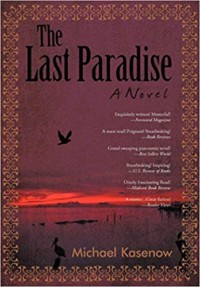Title: The Last Paradise
Author: Michael Kasenow
Publisher: iUniverse
ISBN: 978-1-4401-2001-5
Pages: 315
Genre: Fiction/Historical Fiction
Reviewed by: Carol Daval
Pacific Book Review
Michael Kasenow’s memorable debut novel, The Last Paradise, is an artful and wellcrafted depiction of triumph and tragedy in the engaging and progressive port city of Galveston, Texas during the Post Civil War era. Within a landscape fraught with poverty and racial injustice, this evocative historical fiction shines a light on the human spirit and its ability to rise above even the harshest of life’s circumstances.
In vibrant detail Kasenow reveals turn-of-the century Galveston as a character unto itself. Monikered as the “Wall Street of the Southwest” he paints a tangible city backdrop with palpable contrasts stretching from the silver streets of the upper crust, to the lower socio-economic blight witnessed in the likes of Bleach’s tavern, a place run by a fly-swatting albino. In this “Tin Pan Alley” establishment “working girl” Fanny Brown entertains clients upstairs, while the main floor watering hole provides respite for exslaves, fishermen, card sharps, and even a loveable, simple-minded couple that the community watches over.
Here the friendship of Newt Haskins and drifter Maxwell Hayes is at the center of the story. Their lives and intentions mingle with the quirky inhabitants living in the impoverished “Alley” section of the island domain. While their retaliations against racial conflict, corrupt businesses, and dirty cops, may be outside the law, Kasenow’s creative storytelling delivers portraits of honorable and likeable men. Filled with contrasts of good vs. evil, the latter element is clearly embodied in the character of “Boss” Eugene Connor, a racist businessman stemming from a long line of slave owners, who views Blacks as inferior, and keeps law enforcement in his pocket to the detriment of the community. In an era marred by racial strife, this epic homage to the climate of the day is distinguished by signs such as “No Negroes Allowed” and “Pool Hall for Coloreds.” While skin-color among those living in the “Alley” causes little concern, Kasenow uses those in a position of authority to undermine the freedom and equality of its inhabitants. When Mother Nature delivers a horrific blow to the city with the devastating Sept. 8, 1900 hurricane, Kasenow is spot on in his descriptives. “The worst was yet to come” proves a premonitory indication of the storm’s monumental destructive force. From flying debris and rising waters, to the violent winds, raging sea, and the astronomical toll and sacrifice of human life, readers are drawn into a tempest of epic proportion. Here the smell of death permeates Kasenow’s intense literary exploration of a city’s near annihilation.
While sadness and heartache befall this downtrodden community, Kasenow smartly counters with romantic heroics and some well-dispersed humor. From bets placed on a race involving immobile snails or a snake-bite that warrants an unnecessary snickerinducing remedy, to a shark-fishing contest where dumb-luck produces an unexpected surprise, such moments lend an uplifting air to the story. Easy conversational dialogue flows throughout, while comical banter showcases the teasing camaraderie between characters. Whether sassy jabs from cohorts as Newt prepares for his ordered community service at St. Mary’s orphanage, or the witchy antics of card sharp Sister Ruby in response to her handyman’s curious questions, the exchanges are genuine. In this atmosphere of Jim Crow laws, bigotry, and a lingering Klan mentality, harsh language like “white trash, retards, whores, an’ greedy niggers – I need your attention,” speaks to the timely essence of a story cloaked in the cruel realities of the day. Ultimately a message from the “New South” business elite that “Hope fortifies the community, fear is the enemy of hope” appropriately voices the need for change, in order to move Galveston in a more positive direction.
The Last Paradise is a moving novel that yields a triumphant blend of history, fictional narrative, and vivid characterization. Multi-faceted, richly textured, and truly authentic at its heart this is a story that honors the resiliency of the human spirit, regardless of whether the underlying offense is natural or man-made.


